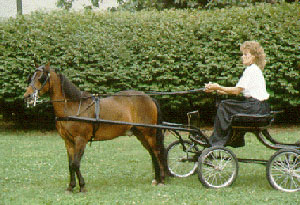

Shetland


Introduction: Often known as "Scotland's Little Giant," the Shetland is the smallest pony breed. The American Shetland is a common sight in both the United States and Canada. The British and American Shetlands have now grown so far apart that they are really two separate breeds; I will eventually have a page for each of them but until then, I will cover them both on this page. The pictures above are a British Shetland and, in harness, an American Shetland. If you have any comments or suggestions, please click here.
Names: Shetland, Shetland Pony. Often called the Sheltie, especially in England.
Origin: The
origins of this ancient breed are believed to stem from the ponies of
Scandinavia (such as Norway
and Sweden),
Ireland, and
Wales, which must have traveled to the Shetland
Islands off the coast of Scotland before the lands separated. They were
subsequently brought to Scotland by the Celts.
Breeding areas and studs: Shetland Isles
originally. Now there in fewer numbers and on the mainland of Scotland and
England. More recently in numerous studs in USA and most recently in many
places in Europe. Stud book maintained by Shetland Pony Stud-Book
Society.
Breeding: In
the United States, selective breeding has produced a more slender pony, better
suited to trotting races. Those shown in harness classes somewhat resemble
miniature Hackneys,
with artificial paces and tails! The Shetland is the most popular of the pony
breeds, with 80,000 registered by the American Shetland Pony Club by 1974.
Indigenous breed of the Shetland Isles. Mentioned in
Viking times and, until a few years ago, used for every type of farm work on the
islands. Has gained much ground as children's pony all over the world
since the end of last century, being ideally suited by temperament for a small
child gaining confidence in horses.
Description: Like
all wild ponies, the Shetland is the product of its original environment.
A rocky terrain made it sure-footed; a meager diet of heather, seaweed, and
marshgrass inhibited its growth; and the cold sea wind brought about its thick
coat, so long and furry in winter that it becomes a rainproof thatch. The
domesticated Shetland thrives best on the barest essentials: hay or grass,
water, and a simple shed for shelter in rough weather.
The Island type, long used in the mines of the British Isles,
looks like a miniature draft horse. The American type has been refined
through selective breeding; its profile is sometimes dished in the Arabian
manner. The description below is essentially the British Shetland.
Action: Smart straight action in walk and trot. Able to carry considerably weight for its size.
Body: A deep chest and round barrel are characteristic. Small, hard, heavily muscled back. Short, thick, strong neck. (One source said the neck should not be either too long or too short and should rise off a well-laid oblique shoulder.) The body must be strong with broad chest and short back. The ribs should be deep.
Color: Varies, including mouse gray, black, bay, brown, chestnut, cream, white, spotted, and dapple. Usually black, brown or chestnut. Can be piebald or skewbald. May be of any colour known in horses and piebalds and skewbalds are common.
Hair: Mane and tail thick and very long; winter coat also very long and dense. Mane and tail should be profuse and the tail well set on.
Head: Small with small ears and muzzle. Should be well shaped and in proportion to body. Large, kind eyes. Fairly straight face.
Legs: Very short. Well boned and muscled (although hind legs are sometimes rather cow-hocked).
Size: About 9.2 hands. Has an average height of 9.3 hands. Today's (1974) purebred ranges from as small as 26 inches (6.5 hands) to the 46-inch (11.5 hand) limit set by the American Shetland Pony Club. Height of registered ponies must not exceed 42 inches when fully grown.
Temperament:
Features:
Evolving in the harsh weather of Scotland and Scandinavia,
Shetlands are extremely hardy and long lived. Although small, they are
also very strong, able to carry half of their body weight, and one can carry a
man with ease. Stout and lively.
The smallest breed of ponies, at one time much used as pit
ponies in view of great strength for size. Very popular as children's
pony. Exceptionally hardy and easy to keep and feed.
Uses: Once
used to carry peat. Popular as pet for riding and driving. In their
native islands, they often transport peat in "kelshies," slung on either side of
the klibber, a wooden saddle. Shetlands were used extensively in the coal
mines of Europe, where it was difficult for even a small child to stand up
straight. Today Shetlands make excellent children's mounts, as long as the
ponies are not spoiled.
Shetlands excel in harness, and perform well in the growing
sport of pony harness racing. They can be good jumpers, too. Pony
jumping events are usually grouped by size. Ponies under 11.2 hands jump 2
feet; 11.2 to 13 hands jump 2 feet 6 inches; 13 to 14.2 jump 3 feet.
Accomplishments:
Curiosities: There is evidence that the Shetland existed as early as 600 A.D. A Celtic stone carving from before the Norse invasions (c. 800 A.D.) shows similar horses. There is a Shetland pony carved on a Pictish (that is, Scottish) monument of A.D. 840.
Profiles: Valkyrie - fetching, well-behaved little black Shetland; once belonged to Prince Andrew and Prince Edward. Dandy - white Shetland stallion; inhabited the Royal Jordanian Stables, where he worked off his high spirits in rough-and-tumble games with his young Bedouin groom. Persi - elderly, sedate and very hairy Shetland who wore scarlet Persian trappings and gave pleasure to the (Iranian) Shah's small daughter, Princess Farahnaz.
Conclusion: